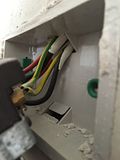Hi,
We're about to replace our kitchen and would like to go over from a gas hob to an induction hob.
We currently have an AEG single oven which can draw 3.5kW (due to the pyrolytic cleaning function). The cabling is 10mm and is connected to a 32A breaker in the consumer unit.
The majority of induction hobs we've looked at are rated at 7.4kW.
So am I ok to get an additional connection added to the existing oven circuit? Is the cabling ok? Is the 32A breaker sufficient or does it need to be upgraded? Or do I need to get a whole new circuit installed?
I'll be getting an electrician to do the work for me, I just wanted to have a bit of knowledge up front ahead of getting quotes.
Many thanks in advance...
We're about to replace our kitchen and would like to go over from a gas hob to an induction hob.
We currently have an AEG single oven which can draw 3.5kW (due to the pyrolytic cleaning function). The cabling is 10mm and is connected to a 32A breaker in the consumer unit.
The majority of induction hobs we've looked at are rated at 7.4kW.
So am I ok to get an additional connection added to the existing oven circuit? Is the cabling ok? Is the 32A breaker sufficient or does it need to be upgraded? Or do I need to get a whole new circuit installed?
I'll be getting an electrician to do the work for me, I just wanted to have a bit of knowledge up front ahead of getting quotes.
Many thanks in advance...



